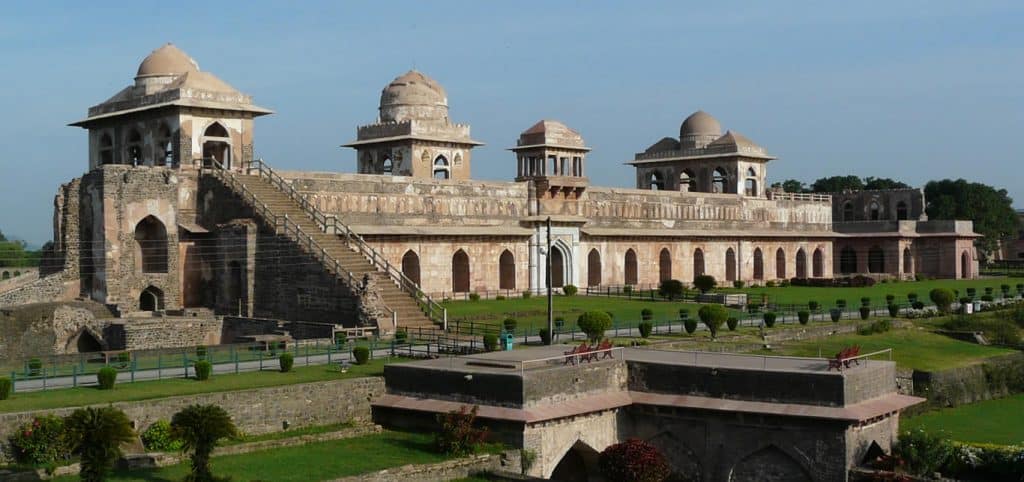An erstwhile princely state, Mandu or Mandavgad located some 90 kms from Indore is celebrated not just for its spectacular architecture- popularly known as the Malwa Architecture but also for the eternal love story of Baz Bahadur and Rani Roopmati – a love that manifested not just into some of the most beautiful architectural wonders that the king built for his queen but also in the love ballads that are sung by the balladeers even today.
Located in the Dhar district of Madhya Pradesh, India, at an altitude of 2,000 feet Mandu, as per known Sanskrit sources has always been a fortified city whose natural defenses and rocky outcrop gave it a considerable strategic position and made it a firm favorite abode of various rulers- Rajput Parmaras, Afghans and Mughals who held sway over the city from time to time. Under these rulers Mandu went on to become one of the most beautiful cities of its times. Palaces like the Jahaz Mahal and Hindola Mahal talked of Mandu’s opulence while ornamental canals, baths and pavilions added a sense of gaiety and festivities earning the city the moniker Shadiabad or the city of joy by the sultans of Malwa.
However, it was the eternal ill fated love story of Baz Bahadur and Rani Roopmati that made Mandu what is today- a celebration in stone, of life and joy. Their love story is what people and balladeers still talk of about even today; a love that got manifested in some of the wonderful monuments that the poet prince built for his beautiful consort.
The Love Story of Baz Bahadur and Rani Roopmati
The story goes that during a hunting expedition, the Afghan Poet Prince Baz Bahadur was drawn to the beautiful Roopmati singing by the banks of the Narmada River. Since both of them loved music, they both fell in love with Roopmati moving to Mandu to be with their prince. However, herein rose a problem, Roopmati regarded the Narmada River as a goddess and refused to do anything without paying the goddess her obeisance and on foggy and rainy days it became even worse for then she had to journeyed miles to get a glimpse of the river. To remedy the issue Baz Bahadur got two chattris built on a military watch post located at the outskirts of the town from where the river was visible. Furthermore, he also got a pond known as Rewa Kund excavated near his palace where sacred water from Narmada was to be found linked through underground source.
Not every Love Story has a Happy Ending
But, as they say not every story has a silver lining, Mandu soon fell under the expanding army of the Mughals and whilst Rani Roopmati poisoned herself on hearing of the eventual fall of Mandu, Baz Bahadur led a fugitive life for several years before joining Akbar’s service though, some say that he too met his doom in the battlefield.
But while their story didn’t had a happy ending, their love story still lingers on in its various ramparts, forts and monuments that the prince built for his beloved queen.
Best time to Visit Mandu
Mandu makes for a nice weekend gateway and one can visit the place any time of the year. While the summer months (March –June) are mildly hot; winters (Oct- Feb) are pleasant albeit the nights are a bit cold. Nonetheless, it is during the monsoon (July-Sept) that the Mandu is at its best when several waterfalls gush down the plateau and the area becomes verdant green making Mandu one of the most romantic historical sites in India.
How to Reach Mandu
Getting to Mandu can be a bit tedious since the city is some 100 kms from the nearest airport at Indore and 125 km from the nearest Railway junction of Ratlam. Nonetheless, taxis and buses are available from the airport and train station for Mandu. By car, the best route from Indore is through Pithampur – Ghatabillod – Labour – Dhar – Mandu. There are regular bus services to Mandu also from Indore, Dhar,Mhow, Ratlam, Ujjain and Bhopal but do note that if coming from Indore one needs to change the bus at Dhar for a local bus to Mandu.
Key important distances from the cities
- 349 km from Ahmedabad
- 292 km from Bhopal
- 591 km from Gwalior
- 152 km from Ujjain
Moving around the city of Mandu
Moving around the city is easy, one can rent out bikes and scooters from the small village at the entrance to the city but not so sure. One can also hire an auto or a taxi and it may take one 5-6 hours to see the important places though it all depends on the individuals.
What to see in Mandu -Point of Interest
Mandu is situated in the Dhar District in Madhya Pradesh. It is known for the Jahaz Mahal, a 15th century palace built by Ghiyas-ud-din, son of Emperor Mohammed Shah. It is a two storied palace located amidst two artificial lakes, the Munj Talab and Kapur Talab. Another prominent attraction in the region is Hoshang’s Tomb, built in 1440 AD.
Mandu is also famous for monuments like the Hathi Mahal, Darya Khan’s Tomb, Dai ka Mahal, Dai Ki Chhotti Behen Ka Mahal, Malik Mughith’s Mosque and Jali Mahal. The Echo Point or the Delphic Oracle, Lohani Caves and Temple Ruins; and the Sunset Point are other important attractions in the region.
The Jami Masjid, Malik Mughith Masjid, Roopmati Pavilion, Bagh Caves, Baz Bahadur’s Palace, Nilkanth Shrine, Ashrafi Mahal, Champa Baoli and Nahar Jharokha are also popular.
Short Tours and Excursions from Mandu
The temple cities of Ujjain, Maheshwar, Omkeshwar and Indore are some of the places that one can take a short excursion too.
To get an idea as to what a Mandu Tour Package will look like, check out our Magical Mandu tour itinerary.

